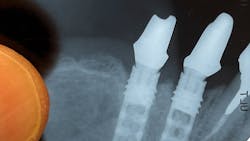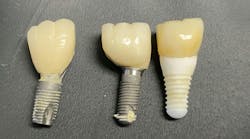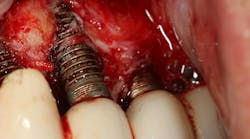What implant is this? How to identify dental implants
There are many ways to attempt to identify unknown dental implants that were used for a patient case: websites, artificial intelligence recognition systems, contacting the dentist who placed the implants, sending a picture or radiograph to the manufacturer, asking members of social media groups, and/or guessing. With more than 40 years of implant experience, I have developed a protocol to identify unknown dental implants. There’s a lot of history surrounding implants, and I’ll use that as my starting point.
Implant history
Brånemark External Hex: The original pioneer implant was the Brånemark implant from Nobelpharma, later renamed Nobel Biocare. The implant was an external hexed implant, designed only for bridges and only with a transmucosal (intermediary) abutment. These implants became so popular that many other clone systems were developed. All were copies with variations in thread size and coating. Implant Innovations Inc., Implant Support Systems, Implamed, and numerous other companies emerged with essentially the same interface. Implant Innovations Inc. later became known as 3i, Biomet 3i, and Zimmer Biomet, and then ZimVie introduced the UCLA abutment or direct-to-fixture castable cylinder. This enabled single-unit screw-retained and custom abutments. These implants comprise many older implant restorations, which, by default, may be made on the Brånemark external hex platform.
Core-vent Internal Connection: Core-vent, which became Dentsply, Paragon, Sulzer, Centerpulse, Zimmer, Zimmer Biomet, and now ZimVie, introduced the first internal connection implants. Their first line was cemented into the implant. If a restoration needs to be made, there are very few restorative options other than remilling whatever was made in the mouth and making a new cemented crown. Later, the company introduced color-coded internal screw-retained and cemented crowns and bridges. This implant is probably the most cloned implant today as many companies have the same interface. MIS to BioHorizons to Adin to Implant Direct, and many more.
Straumann Tissue Level: Straumann introduced the tissue-level implant, which was unique in that it had a chamfer that the final crown (both screw-retained and cemented) rested on. This implant has had many clones over the years.
Astra/Dentsply: Astra, which is now part of Dentsply, has been around for many years as well. They have a Morse taper interface and micro-threads at the top portion of the implant. By identifying the interface, or previous restoration and screws and then looking at the x-ray, one can determine if it is an Astra and, if so, which generation. The original implant was solely Morse-tapered as was the Straumann Tissue Level implant. An engaging internal component was added later. When identifying these implants, it is important to know which generation they are. While the parts may be similar, they are not interchangeable. If you look at the x-ray, you can see the internal walls and whether they are engaging or nonengaging. The restorative parts will also confirm this. Sometimes I’ll buy two impression copings (old and new styles) and have the dentist x-ray which one works. Then I buy the analogs, etc.
Also by the author:
- The crown the lab made doesn't fit: Why does this happen?
- Why do we get dental crowns that don't fit?
- Top 5 questions you should ask a lab before you send them a case
- Prevention of titanium base debonding and failure
Why is all this so important? Since the implant restoration you are trying to identify is quite possibly more than 20 years old, it may just be one of these implants.
My implant identification protocol
- Radiograph: I always request x-ray images downloaded from the software. (I’d rather not get a picture taken of image on the computer screen.) This allows me to play with the balance, contrast, brightness, and size of the picture, which makes identification so much easier. I have every implant catalog I have ever received from every sales rep in the last four decades for reference.
- Implant interface: Look at the interface rather than the implant body. I can look at any x-ray and expand the interface of the implant and look for internal or external hex. If, for example, it looks like a Brånemark regular-diameter implant, I’m done. If the diameter is wider or smaller, I’ll check the platform versus the hex to further establish which implant company made this diameter of implant. For example, Nobel Biocare had wider- and smaller-diameter implants where the external hex and thread hole are wider to match. 3i had wide and narrow implant platforms with the same external hex and thread hole as the regular diameter. This makes a Nobel Biocare 5 mm implant incompatible with the 3i 5 mm. In the case of the Core-vent Zimmer implant, it’s very easy. The regular has a taper, and the wide implant is flat. The internal hex connection is the same for both sizes. If the implant is an original Core-vent, there will be a hole at the bottom of it. Straumann Tissue Level is the easiest to identify, but some clones have changed the thread and internal connection. In this case, we cannot use Straumann parts but instead need to get the parts designed by the manufacturer of the implant. Unfortunately, many of these companies have long gone out of business.
- Implant body: After identifying the interface, look at the implant itself. Early implants were not threaded. For example, Core-vent’s first implants were cylinders with a hole at the bottom. The Innova Endopore implant was tapered with a porous surface. It’s very recognizable, and a quick comparison to the catalog or internet image can help in identification. This company made a Brånemark- and Straumann-compatible implant. So, even though they no longer exist, you can get the parts.
- Implant screw: The screw is another great clue as to which implant was placed. A 3i Certain implant screw has a long shaft and threads at the bases. After examining the implant shape, threads, internal interface, and long shaft, one can fully confirm that it was a Certain implant. We have gold screws, gold-plated screws, black screws, gray screws, hex screws, octagon screws, square screws, and many more. Nobel Biocare uses the Uniscrew and Straumann Octagon screw. If that type of screw was used, it likely has genuine implant parts. Because of clone restorative parts, the screw may not match the implants. However, the shape and depth that the screw goes into the implant is the same. Combined with the x-rays of the implant and the interface, one can be quite certain which implant was placed.
- Implant dentist/geography: When I get an x-ray for implant identification, I often ask who placed the implant and where it was placed. If we know who the dentist was (and if he/she is no longer practicing), the implant surgeon may have the specific implants they used. If we don’t know who the surgeon was, the location is useful. For example, an implant that looked like Straumann and was placed in a geographical area where Straumann clones are popular (for example, Implant Direct makes a Straumann clone), it may be the clone company that has parts different from those of the original manufacturer.
Conclusion
When beginning the identification process, always start with the three big implant companies: Nobel/Brånemark, 3i, and Straumann. For short-lived implants, wacky-designed implants, and other popular implants, use the same identification protocol. Calcitek Integral, Omilok, and Spline implants are all unique and have been out of production for many years. Look at the interface first. If it has the old crown or bridge, look at that. Use the restorative parts on the implant to compare them to the parts your lab may have lying around. Once the implant brand and size are confirmed, a few companies, such as Titan or Preat, may sell parts for older implants. In rare cases, customized parts can be made. Even though an old implant company may have been bought by another company, there may be old parts still lying around. Labs, like Marotta Labs, that have been around a long time may have old implant parts lying around as well. Identifying implants is not that difficult if you know their history. Older lab personnel can be especially adept at helping you with identification.
Editor’s note: This article originally appeared in Perio-Implant Advisory, a chairside resource for dentists and hygienists that focuses on periodontal- and implant-related issues. Read more articles and subscribe to the newsletter.
About the Author
Steven Pigliacelli, MDT, CDT
Steven Pigliacelli, MDT, CDT, has more than 30 years’ experience as a dental implant specialist. He is the owner and vice president of Marotta Dental Studio and serves as the technical liaison between the dentist and the laboratory. He also directs the lab’s GPR and Prosthetic Resident Rotation. He is a faculty instructor in postgraduate prosthodontics at New York University, College of Dentistry, in the department of prosthodontics. Contact him at marottadental.com or (866) 627-6882.
Updated August 2, 2023



